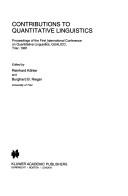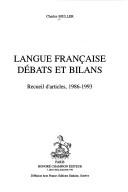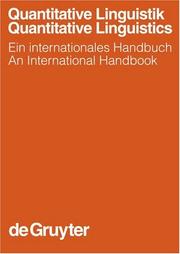| Listing 1 - 9 of 9 |
Sort by
|

ISBN: 0792321979 Year: 1993 Publisher: Dordrecht ; Boston, MA ; London : Kluwer,
Abstract | Keywords | Export | Availability | Bookmark
 Loading...
Loading...Choose an application
- Reference Manager
- EndNote
- RefWorks (Direct export to RefWorks)
Book
Year: 1979 Publisher: Genève : Slatkine,
Abstract | Keywords | Export | Availability | Bookmark
 Loading...
Loading...Choose an application
- Reference Manager
- EndNote
- RefWorks (Direct export to RefWorks)
Book
Year: 1964 Publisher: Paris : Didier,
Abstract | Keywords | Export | Availability | Bookmark
 Loading...
Loading...Choose an application
- Reference Manager
- EndNote
- RefWorks (Direct export to RefWorks)
FRANCAIS (LANGUE) --- LINGUISTIQUE QUANTITATIVE --- FRANCAIS (LANGUE) --- LINGUISTIQUE QUANTITATIVE
Periodical
Year: 1984 Publisher: Genève Paris Slatkine-Champion
Abstract | Keywords | Export | Availability | Bookmark
 Loading...
Loading...Choose an application
- Reference Manager
- EndNote
- RefWorks (Direct export to RefWorks)
Book
ISBN: 2051004447 9782051004442 Year: 1979 Volume: 4 Publisher: Genève Slatkine
Abstract | Keywords | Export | Availability | Bookmark
 Loading...
Loading...Choose an application
- Reference Manager
- EndNote
- RefWorks (Direct export to RefWorks)
French language --- Mathematical linguistics --- Linguistique quantitative --- --mélanges --- --French language --- --Mathematical linguistics
Periodical
Abstract | Keywords | Export | Availability | Bookmark
 Loading...
Loading...Choose an application
- Reference Manager
- EndNote
- RefWorks (Direct export to RefWorks)
Book
ISBN: 2853440222 2040043195 9782040043193 9782853440226 Year: 1975 Volume: 22 Publisher: Paris
Abstract | Keywords | Export | Availability | Bookmark
 Loading...
Loading...Choose an application
- Reference Manager
- EndNote
- RefWorks (Direct export to RefWorks)
Lexicology. Semantics --- French language --- Grammar --- Grammar, Comparative and general --- Subordinate constructions. --- Subordonnées (Linguistique) --- Français (Langue) --- Subordinate constructions --- Subordonnées --- Linguistique quantitative

ISBN: 2852032996 9782852032996 Year: 1993 Volume: 51 Publisher: Paris : Editions Honoré Champion,
Abstract | Keywords | Export | Availability | Bookmark
 Loading...
Loading...Choose an application
- Reference Manager
- EndNote
- RefWorks (Direct export to RefWorks)
French language --- Français (Langue) --- Linguistique française --- --French language --- Langue d'oïl --- Romance languages --- Français (Langue) --- FRANCAIS (LANGUE) --- LINGUISTIQUE QUANTITATIVE --- LINGUISTIQUE FRANCAISE

ISBN: 3110155788 9783110155785 9786612193446 1282193449 3110194147 9783110194142 9783110146943 3110146940 9783110194128 3110194120 Year: 2008 Volume: 27 27 27 Publisher: Berlin Boston
Abstract | Keywords | Export | Availability | Bookmark
 Loading...
Loading...Choose an application
- Reference Manager
- EndNote
- RefWorks (Direct export to RefWorks)
Over the past two decades, statistical and other quantitative concepts, models and methods have been increasingly gaining importance and interest in all areas of linguistics and text analysis, as well as in a number of neighboring disciplines and areas of application. The term "quantitative linguistics" comprises all scientific and technical approaches which use such terms and methods in the analysis of or work with language(s), texts and other related subjects. The 71 articles in this handbook, written by internationally-recognized experts, offer a broad, up-to-date overview of the scientific-theoretical principles, the history, the diversity of the subject areas studied, the methods and models used, the results obtained thus far and their applications. The articles are divided up into thirteen chapters: the first chapter includes contributions on the basic principles and the history of the field, nine additional chapters are dedicated to individual descriptions of the levels of linguistic research (from phonology to pragmatics) as well as typological, diachronic and geolinguistic questions. The next two chapters include a description of important models, hypotheses and principles; selected areas of application; and references to neighboring disciplines. The last portion of the handbook is an informative contribution, with information about publication forums, bibliographies, major projects, Internet links, etc. This handbook is useful not only for researchers, teachers and students of all branches of linguistics and the philologies, but also for scientists in neighboring fields, whose theoretical and empirical research touches on linguistic questions (for instance, psychology and sociology), or for those who want to make use of the proven methods or results from quantitative linguistics in their own research. Statistische und andere quantitative Konzepte, Modelle und Verfahren gewinnen seit nunmehr zwei Jahrzehnten in allen Bereichen der Sprach- und Textwissenschaften und einer Reihe von Nachbardisziplinen sowie Anwendungsgebieten zunehmend Bedeutung und Interesse. Unter der Bezeichnung "Quantitative Linguistik" fasst man alle wissenschaftlichen und technischen Ansätze zusammen, die solche Begriffe und Methoden bei der Analyse von bzw. bei der Arbeit mit Sprache(n), Texten und verwandten Gegenständen anwenden. Die 71 Beiträge zu diesem Handbuch, die von weltweit anerkannten Fachleuten verfasst wurden, bieten einen breiten und aktuellen Überblick über die wissenschaftstheoretischen Grundlagen, die Geschichte, die Vielfalt der untersuchten Gegenstandsbereiche, über die verwendeten Methoden und Modelle und über bisher gewonnene Resultate und ihre Anwendungen. Die Artikel sind in 13 Kapitel gegliedert: Im ersten sind Beiträge zu den Grundlagen und zur Geschichte zusammengefasst, 9 weitere Kapitel widmen sich Einzeldarstellungen zu den linguistischen Untersuchungsebenen (von der Phonologie bis zur Pragmatik) sowie zu typologischen, diachronen und geolinguistischen Fragestellungen. Eine Darstellung von wichtigen Modellen, Hypothesen und Gesetzen, von ausgewählten Anwendungsgebieten und Bezügen zu Nachbardisziplinen folgt in zwei eigenen Kapiteln. Den Abschluss bildet ein informativer Beitrag mit Informationen über Publikationsforen, Bibliographien, Großprojekten, Internetlinks etc. Adressaten des Handbuchs sind neben Forschern, Lehrenden und Studierenden aller Zweige der Sprachwissenschaften einschließlich und der Philologien auch Wissenschaftler benachbarter Fächer, deren theoretische und empirische Forschung sprachwissenschaftliche Fragen berührt (wie Psychologie und Soziologie) bzw. die bewährte Methoden oder Resultate aus der quantitativen Linguistik für die eigenen Fragestellungen nutzbar machen wollen.
Mathematical linguistics --- Mathematical linguistics. --- Algebraic linguistics --- Language and languages --- Linguistics --- Linguistics, Mathematical --- Applied linguistics --- Information theory --- Computational linguistics --- Statistical methods --- Mathematical models --- Linguistics. --- Linguistic science --- Science of language --- Quantitative linguistics. --- LINGUISTIQUE QUANTITATIVE --- GUIDES, MANUELS, ETC.
| Listing 1 - 9 of 9 |
Sort by
|

 Search
Search Feedback
Feedback About UniCat
About UniCat  Help
Help News
News